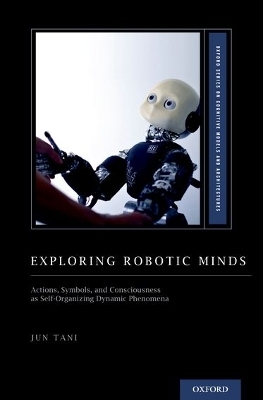
Exploring Robotic Minds
Oxford University Press Inc (Verlag)
978-0-19-028106-9 (ISBN)
In Exploring Robotic Minds: Actions, Symbols, and Consciousness as Self-Organizing Dynamic Phenomena, Jun Tani sets out to answer an essential and tantalizing question: How do our minds work? By providing an overview of his "synthetic neurorobotics" project, Tani reveals how symbols and concepts that represent the world can emerge in a neurodynamic structure--iterative interactions between the top-down subjective view, which proactively acts on the world, and the bottom-up recognition of the resultant perceptual reality. He argues that nontrivial problems of consciousness and free will could be addressed through structural understanding of such iterative, conflicting interactions between the top-down and the bottom-up pathways.
A wide range of readers will enjoy this wonderful journey of the mind and will follow the author on interdisciplinary discussions that span neuroscience, dynamical systems theories, robotics, and phenomenology. The book also includes many figures, as well as a link to videos of Tani's exciting robotic experiments.
Jun Tani is a Professor in the Department of Electrical Engineering at Korean Advanced Institute of Science and Technology (KAIST).
Foreword by Frank E. Ritter
Preface
Part I On the Mind
1. Where do we begin with mind?
2. Cognitivism
2.1 Composition and recursion in symbol systems
2.2 Some cognitive models
2.3 The symbol grounding problem
2.4 Context
2.5 Summary
3. Phenomenology
3.1 Direct experience
3.2 The subjective mind and objective world
3.3 Time perception: How can the flow of subjective experiences be objectified?
3.4 Being-in-the-world
3.5 Embodiment for mind
3.6 Stream of consciousness and freewill
3.7 Summary
4. Introducing the brain and brain science
4.1 Hierarchical brain mechanisms for visual recognition and action generation
4.2 A new understanding of action generation and recognition in the brain
4.3 How can intention arise spontaneously and be aware consciously?
4.4 Deciding between the conflicting evidence
4.5 Summary
5. Dynamical systems approach for embodied cognition
5.1 Dynamical systems
5.2 Gibsonian and Neo-Gibsonian approaches
5.3 Behavior-based robotics
5.4 Modeling the brain at different levels
5.5 Neural network models
5.6 Neurorobotics with the dynamical systems perspectives
5.7 Summary
Part II Emergent minds: Findings from robotics experiments
6. New proposals
6.1 Robots with subjective views
6.2 Engineering subjective views into neurodynamic models
6.3 The subjective mind and the objective world as an inseparable entity
7. Predictive learning about the world from actional consequences
7.1 Development of compositionality: The symbol grounding problem
7.2 Predictive dynamics and self-consciousness
7.3 Summary
8. Mirroring action generation and recognition with articulating sensory-motor flow
8.1 A mirror neuron model: RNNPB
8.2 Embedding multiple behaviors in distributed representation
8.3 Imitating others by recognizing their mental states
8.4 Binding language and actions
8.5 Summary
9. Development of functional hierarchy for action
9.1 Self-organization of functional hierarchy in multiple timescales
9.2 Robotics experiments on developmental training of complex actions
9.3 Summary
10. Freewill for action
10.1 Dynamic account of spontaneous behaviors
10.2 Freewill, consciousness, and postdiction
10.3 Summary
11. Conclusions
11.1 Compositionality in cognitive mind
11.2 Phenomenology
11.3 Objective science and subjective experience
11.4 Future directions
11.5 Summary of the book
Glossary for abbreviations
References
Index
| Erscheinungsdatum | 15.11.2016 |
|---|---|
| Reihe/Serie | Oxford Series on Cognitive Models and Architectures |
| Verlagsort | New York |
| Sprache | englisch |
| Maße | 165 x 243 mm |
| Gewicht | 612 g |
| Themenwelt | Geisteswissenschaften ► Philosophie |
| Geisteswissenschaften ► Psychologie ► Allgemeine Psychologie | |
| Geisteswissenschaften ► Psychologie ► Biopsychologie / Neurowissenschaften | |
| Geisteswissenschaften ► Psychologie ► Pädagogische Psychologie | |
| Geisteswissenschaften ► Psychologie ► Psychoanalyse / Tiefenpsychologie | |
| Geisteswissenschaften ► Psychologie ► Sozialpsychologie | |
| Geisteswissenschaften ► Psychologie ► Verhaltenstherapie | |
| Informatik ► Theorie / Studium ► Künstliche Intelligenz / Robotik | |
| ISBN-10 | 0-19-028106-5 / 0190281065 |
| ISBN-13 | 978-0-19-028106-9 / 9780190281069 |
| Zustand | Neuware |
| Haben Sie eine Frage zum Produkt? |
aus dem Bereich


